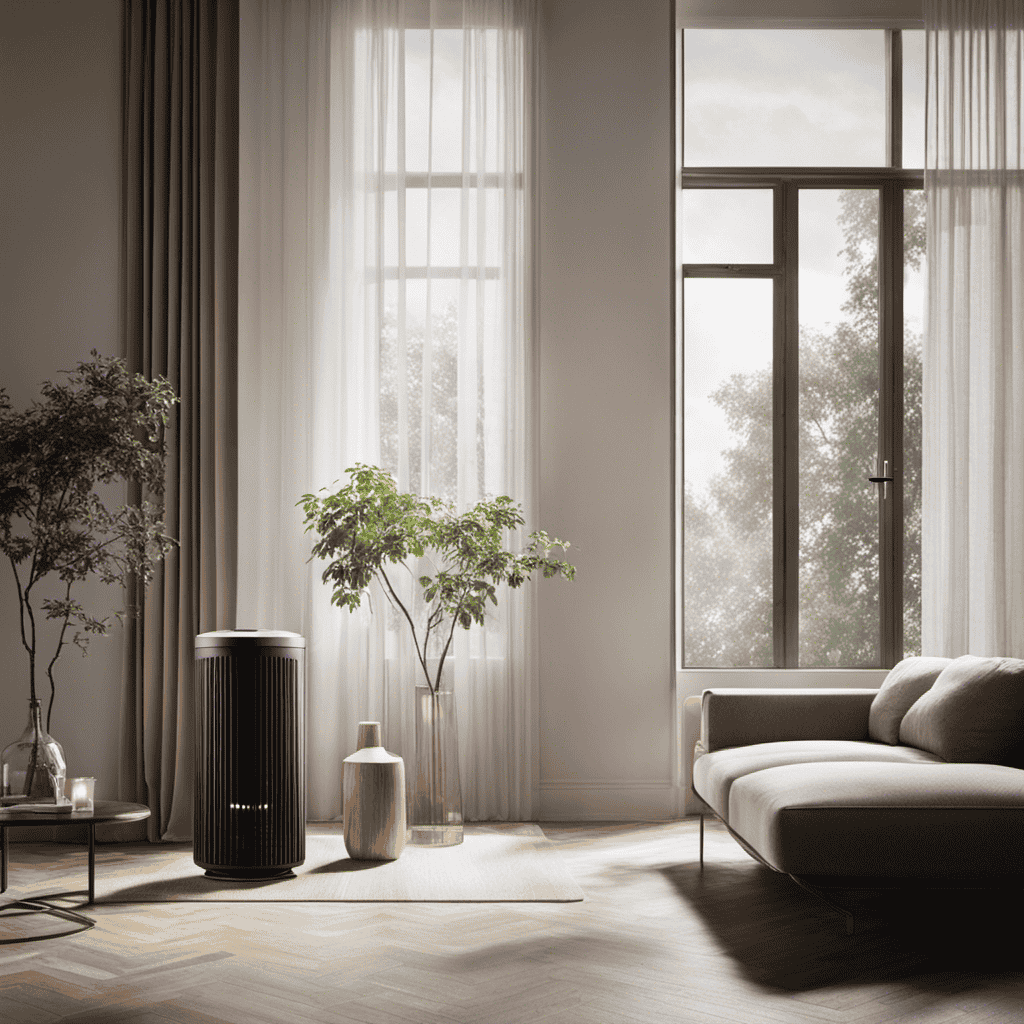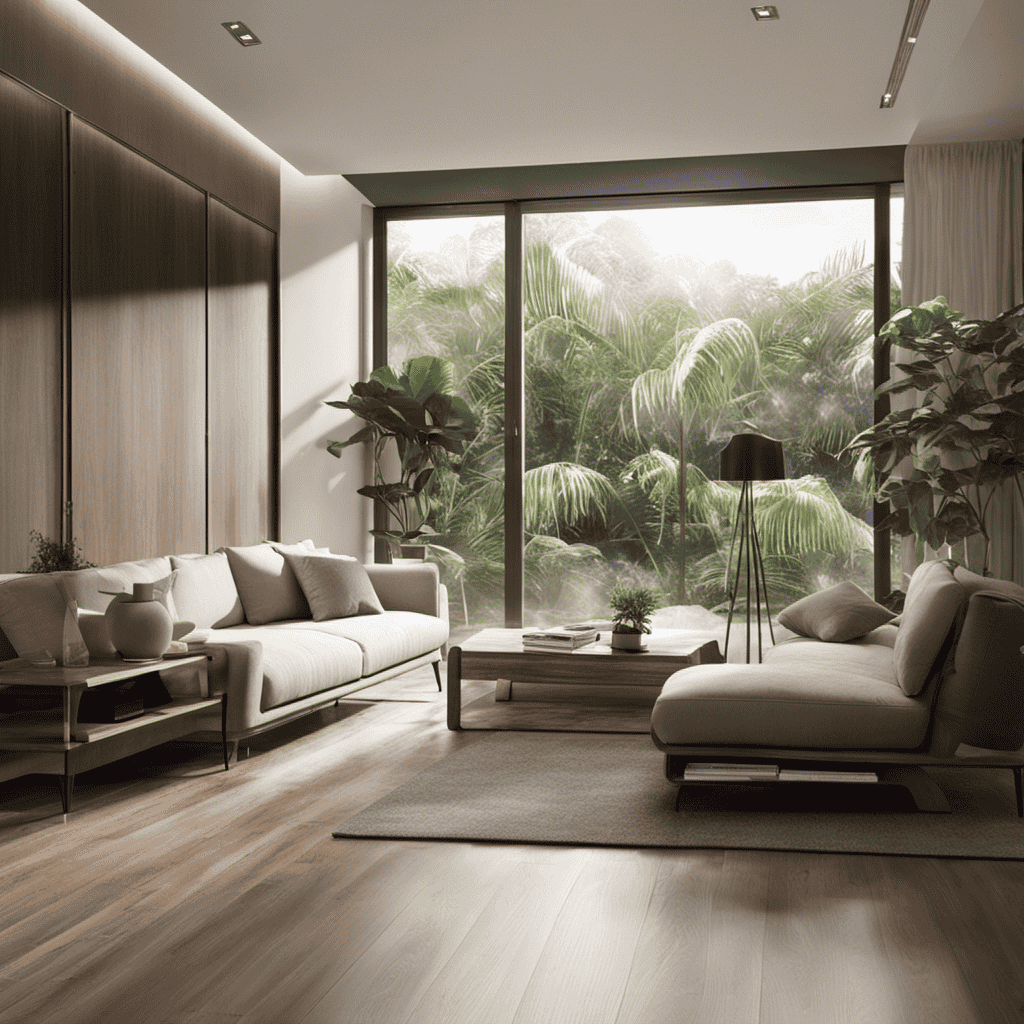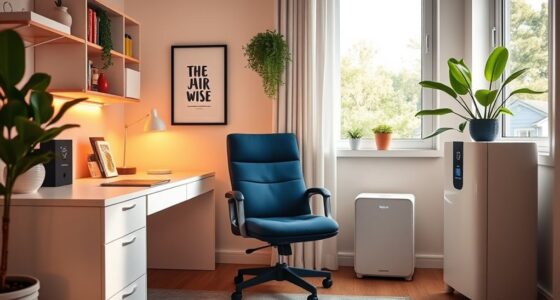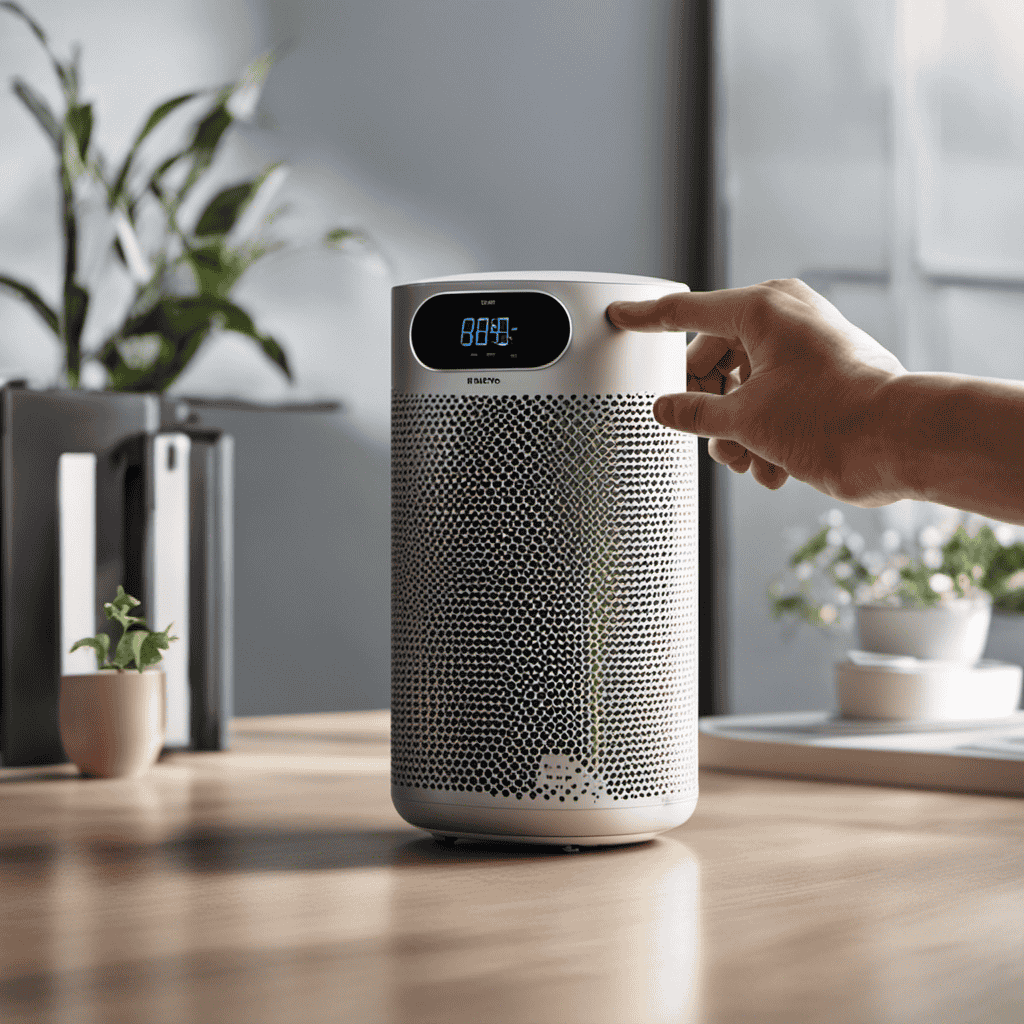If you care about breathing fresh air and need to pick the right air purifier, it’s important to weigh the benefits and drawbacks. Learn more about them to make the best choice for your space.
In this article, we’ll explore the efficiency, health benefits, cost effectiveness, and maintenance of air purifiers.
We’ll also delve into the different types of air purification technologies, potential side effects and risks, as well as the environmental impact.
By weighing these factors, you’ll be equipped to choose the best air purifier for your needs.
Key Takeaways
- Air purifiers improve air quality by removing harmful particles and allergens.
- Air purifiers reduce the risk of respiratory issues and allergies.
- Air purifiers alleviate symptoms of allergies and asthma.
- Air purifiers enhance overall comfort by reducing odors and stale air.
Efficiency of Air Purifiers
Air purifiers can effectively remove airborne pollutants and allergens from the air. When considering the efficiency of air purifiers, two key factors to examine are energy consumption and the overall effectiveness of these devices.
Energy consumption is an important aspect to consider when evaluating air purifiers. Many models on the market today are designed to be energy efficient, consuming minimal electricity while providing optimum performance. This is particularly beneficial for individuals concerned about energy usage and its impact on the environment. By choosing an energy-efficient air purifier, you can effectively improve the air quality in your home without significantly increasing your electricity bill.
In terms of effectiveness, air purifiers are designed to capture and remove a wide range of airborne pollutants, including dust, pet dander, pollen, mold spores, and even bacteria and viruses. However, it is important to note that while air purifiers can effectively remove these pollutants, they may not eliminate them completely. The effectiveness of an air purifier can vary depending on factors such as the size of the room, the specific pollutants present, and the type of filtration system used.
Health Benefits of Using an Air Purifier
Using an air purifier can help alleviate symptoms of allergies and asthma. It is a common solution for individuals who suffer from respiratory issues or have allergies. Air purifiers work by removing airborne particles such as dust, pollen, pet dander, and mold spores from the air, improving the overall air quality in your home.
Here are some key points to consider about the health benefits of using an air purifier:
-
Effectiveness on Allergies:
-
Air purifiers can effectively reduce allergens in the air, providing relief for those with allergies.
-
They can capture and trap particles as small as 0.3 microns, including common allergens like pollen and dust mites.
-
Some air purifiers also have HEPA filters, which are highly efficient in removing allergens from the air.
-
Energy Consumption:
-
Air purifiers consume varying levels of energy depending on their size and features.
-
Look for Energy Star certified purifiers, as they are designed to be energy-efficient and can help reduce electricity costs.
-
Additional Health Benefits:
-
Air purifiers can also help remove odors and smoke from the air, making your home more pleasant to live in.
-
They can create a cleaner environment, which may lead to better sleep and improved overall well-being.
Cost Effectiveness of Air Purifiers
When it comes to considering the cost effectiveness of air purifiers, you’ll want to evaluate factors like energy consumption and long-term maintenance expenses.
Energy consumption is an important aspect to consider when determining the cost effectiveness of an air purifier. Look for models that are energy efficient and have low power consumption. This will help you save on electricity bills in the long run.
Long-term benefits are another key factor to consider. While air purifiers may require an initial investment, they can provide significant long-term benefits. By improving indoor air quality, air purifiers can help prevent respiratory issues and allergies, leading to reduced medical expenses and improved overall health.
When comparing the cost of air purifiers, don’t forget to factor in maintenance expenses. Some models require regular filter replacements, which can add up over time. Look for air purifiers that have washable or reusable filters to minimize ongoing maintenance costs.
Maintenance and Filter Replacement
In this discussion, I will be exploring the cost of replacements, frequency of maintenance, and the impact on air quality when it comes to air purifiers.
One important factor to consider is the cost of replacing filters, as this can vary greatly depending on the brand and model of the air purifier.
Additionally, the frequency of maintenance required for air purifiers can also differ, with some needing more frequent filter changes or cleaning than others.
Lastly, it is crucial to examine the impact that air purifiers have on air quality, and whether they effectively remove pollutants and allergens from the environment.
Cost of Replacements
The cost of replacements for air purifiers can quickly add up. When considering the long term savings of owning an air purifier, it is important to take into account the lifespan of the filters.
Here are some key points to consider:
-
Lifespan of filters: Air purifiers typically require filter replacements every 6 to 12 months, depending on the model and usage. It is crucial to research the specific lifespan of the filters for the air purifier you are interested in.
-
Cost of replacement filters: Replacement filters can vary in price depending on the brand and model. It is advisable to compare prices and consider the long term cost of maintaining the air purifier.
-
Maintenance costs: In addition to filter replacements, air purifiers may require other maintenance, such as cleaning or replacing pre-filters. These costs should also be factored into the overall cost of ownership.
Considering the lifespan of filters and the potential maintenance costs, it is essential to evaluate the long term savings when investing in an air purifier.
Frequency of Maintenance
Regular maintenance is necessary to keep an air purifier functioning effectively. Properly maintaining your air purifier not only ensures its longevity but also maximizes its efficiency in improving indoor air quality.
The cost of maintenance may vary depending on the type and model of the air purifier, but it is generally affordable compared to the benefits it provides. It is recommended to follow a regular maintenance schedule to keep your air purifier in optimal condition. This typically includes cleaning or replacing the filters, checking and cleaning the fan and vents, and ensuring proper airflow.
By regularly maintaining your air purifier, you can ensure that it continues to effectively remove pollutants from the air, contributing to a healthier living environment.
Transition: Now that we understand the importance of regular maintenance, let’s explore how air purifiers impact air quality.
Impact on Air Quality
To maximize the impact of your air purifier on air quality, it’s important to understand how it works and how it can benefit you. Here are three key points to consider:
- Air purifiers effectively remove particles and pollutants from the air, improving indoor air quality and reducing the risk of respiratory issues.
- They help eliminate allergens such as dust mites, pet dander, and pollen, providing relief for allergy sufferers.
- The long-term benefits of using an air purifier include reducing odors, controlling humidity levels, and preventing the spread of airborne viruses and bacteria.
Research shows that air purifiers can significantly improve air quality by removing harmful particles and allergens. They are especially beneficial for individuals with allergies, asthma, or other respiratory conditions.
Additionally, the long-term benefits of using an air purifier include creating a healthier living environment and reducing the risk of respiratory infections.
Incorporating an air purifier into your home or office can have a positive impact on your overall well-being.
Noise Levels of Air Purifiers
One downside of air purifiers is that they can be noisy, which may disturb your sleep. When choosing an air purifier, it’s essential to consider the noise levels it produces. Some models are designed to operate quietly, while others can be quite loud. To give you an idea of the noise levels, here is a comparison table:
| Noise Level | Description | Example |
|---|---|---|
| Quiet | Barely noticeable | Library |
| Moderate | Background noise | Conversation |
| Loud | Noticeable | Vacuum cleaner |
| Very loud | Disruptive | Construction site |
To ensure a peaceful sleep, opt for air purifiers with noise levels considered quiet or moderate. However, it’s important to note that noise levels can vary depending on the fan speed and air purifier settings.
In terms of effectiveness, air purifiers can remove various airborne particles such as dust, pollen, pet dander, and mold spores. They can also capture harmful pollutants like smoke and volatile organic compounds (VOCs). However, the effectiveness of an air purifier depends on factors such as the size of the room, the type of filter used, and the airflow rate. It’s important to choose an air purifier that matches your specific needs and room size to achieve optimal results.
Transitioning to the next section, let’s explore the different types of air purification technologies available.
Types of Air Purification Technologies
When it comes to air purification technologies, there are several key points to consider.
First, the debate between HEPA filters and ionizers is a common one. While HEPA filters are highly effective at capturing particles, ionizers use charged ions to remove contaminants from the air.
Second, the use of UV-C and ozone in air purifiers is another controversial topic. While UV-C light can kill bacteria and viruses, ozone can be harmful to humans and should be used with caution.
Lastly, active carbon filters are often included in air purifiers to remove odors and chemicals from the air.
Overall, understanding these different technologies can help individuals make an informed decision when selecting an air purifier.
HEPA Vs. Ionizers
If you want to improve indoor air quality, consider using a HEPA filter instead of an ionizer. While both options are commonly used in air purifiers, they differ in their effectiveness and performance. Here are three reasons why a HEPA filter is a better choice:
-
HEPA filters are highly efficient at capturing small particles, such as dust, pollen, and pet dander. They can remove up to 99.97% of airborne contaminants, improving the quality of the air you breathe.
-
Unlike ionizers, HEPA filters do not produce any ozone or other harmful byproducts. This makes them safer for individuals with respiratory conditions, such as asthma or allergies.
-
HEPA filters have a longer lifespan compared to ionizers. They can typically last for several months before needing replacement, making them a cost-effective option in the long run.
Overall, when it comes to improving indoor air quality, a HEPA filter is a more effective and reliable choice over an ionizer.
UV-C and Ozone
To improve indoor air quality, you should be aware that UV-C light can effectively kill bacteria and viruses, while ozone generators can help eliminate odors. However, it is important to consider the safety aspects of using UV-C light and ozone in air purifiers.
UV-C light can be harmful to humans if directly exposed to the eyes or skin, so it is crucial to ensure that the air purifier has proper shielding to prevent any UV-C leakage. Ozone emissions from ozone generators can also be hazardous, especially when present in high concentrations. It is recommended to choose air purifiers that have low ozone emissions or opt for alternative technologies.
Now, let’s delve into the benefits and drawbacks of using active carbon filters in air purifiers.
Active Carbon Filters
When it comes to air purifier technology, one of the most commonly used features is active carbon filters. These filters are designed to remove odors, gases, and volatile organic compounds (VOCs) from the air, making them a popular choice for those who want to improve indoor air quality.
Here are three key benefits of active carbon filters in air purifiers:
-
Effective Odor Removal: The porous structure of activated carbon allows it to trap and adsorb odorous molecules, resulting in fresher and cleaner air.
-
Chemical and Gas Filtration: Active carbon filters have the ability to capture harmful gases, such as formaldehyde and benzene. This makes them highly effective in reducing exposure to indoor pollutants.
-
Extended Filter Lifespan: Compared to other filter types, active carbon filters tend to have a longer lifespan. They can typically last for several months before needing replacement, which helps to reduce maintenance costs.
Overall, active carbon filters are an important component of air purifier technology, offering effective odor and gas removal, as well as a longer filter lifespan.
Potential Side Effects and Risks
Be aware of the potential side effects and risks associated with using an air purifier. While air purifiers can be effective in improving indoor air quality, it is important to consider the potential long-term effects and safety concerns.
One potential long-term effect of using an air purifier is the risk of ozone exposure. Some air purifiers emit ozone as a byproduct of their purification process. Ozone can irritate the respiratory system and worsen symptoms for individuals with asthma or other respiratory conditions. Additionally, long-term exposure to high levels of ozone has been linked to respiratory problems and lung damage.
Another safety concern is the accumulation of harmful chemicals in the filters of air purifiers. As air passes through the filters, pollutants such as volatile organic compounds (VOCs) and formaldehyde can get trapped. Over time, these chemicals can build up in the filters and potentially be released back into the air. This can lead to indoor air pollution and pose health risks to individuals in the vicinity.
It is important to carefully select an air purifier that does not emit ozone and has effective filtration systems to minimize the risk of these potential long-term effects and safety concerns. Regular maintenance and filter replacement are also crucial to ensure the proper functioning of the air purifier and to prevent the accumulation of harmful chemicals.
Environmental Impact of Air Purifiers
The environmental impact of air purifiers can be significant if they are not energy-efficient and contribute to increased electricity consumption. It is important to consider the carbon footprint and long-term effects of these devices.
Here are three key points to grab your attention:
-
Energy Efficiency: Choosing an energy-efficient air purifier can help minimize the environmental impact. Look for models with the Energy Star label, as they are designed to consume less electricity while still providing effective air cleaning.
-
Filter Replacement: Regularly replacing air purifier filters is essential for maintaining their efficiency. Opt for models with washable or reusable filters to reduce waste and minimize the need for frequent replacements.
-
Proper Use: Using air purifiers only when necessary can help reduce electricity consumption. Running them continuously and in rooms with good ventilation may not always be essential, especially if the air quality in your area is relatively good.
Considering the carbon footprint and long-term effects of air purifiers is crucial for making sustainable choices. By selecting energy-efficient models, regularly replacing filters, and using them judiciously, we can minimize their environmental impact and contribute to a greener future.
What are the Pros and Cons of Using an Air Purifier?
One of the major benefits of air purifiers is their ability to remove pollutants and allergens from the air, which can significantly improve indoor air quality and reduce allergy symptoms. However, some cons include the cost of purchasing and maintaining an air purifier, as well as the noise they can generate.
Frequently Asked Questions
Can Air Purifiers Eliminate All Types of Indoor Air Pollutants?
Air purifiers are effective in reducing indoor air pollutants, but they have limitations. They can eliminate common pollutants like dust, pollen, and pet dander. However, they may not be able to remove all types of pollutants, such as volatile organic compounds (VOCs) or mold spores.
It’s important to choose the right type of air purifier for your specific needs. Additionally, considering other strategies like proper ventilation and reducing the source of pollutants is crucial to ensure an overall healthy indoor environment.
How Long Do Air Purifier Filters Typically Last Before They Need to Be Replaced?
Air purifier filters typically last for several months before needing to be replaced. However, the lifespan can vary depending on factors such as the quality of the filter and the level of pollutants in the air.
To clean air purifier filters effectively, it is important to follow the manufacturer’s instructions. Additionally, there are several tips for extending the lifespan of air purifier filters, such as vacuuming or washing them regularly and keeping the surrounding area clean.
Are There Any Health Risks Associated With Using an Air Purifier for an Extended Period of Time?
Using an air purifier for an extended period of time may have some health risks.
For example, if the filters are not regularly cleaned or replaced, they can become a breeding ground for bacteria and mold, which can then be released into the air.
Additionally, some air purifiers emit ozone, which can irritate the respiratory system and worsen existing lung conditions.
However, it’s important to note that when used properly and with clean filters, air purifiers can provide significant health benefits by improving indoor air quality.
Do Air Purifiers Remove Odors From the Air, Such as Those Caused by Cooking or Pets?
Yes, air purifiers can remove odors from the air, including those caused by cooking or pets. With advancements in air purifier technology, they are now equipped with filters that can effectively capture and eliminate odors.
This is beneficial not only for maintaining a fresh and clean indoor environment, but also for improving air quality and reducing potential health risks associated with unpleasant odors.
In offices, air purifiers can create a more pleasant and comfortable working environment for employees.
Can Air Purifiers Help Reduce the Spread of Airborne Viruses and Bacteria in a Household?
Air purifiers have been shown to be effective in reducing the spread of airborne viruses and bacteria in a household. They act as a shield, filtering out harmful particles and creating a cleaner, healthier environment.
Research has also demonstrated their effectiveness in reducing allergy symptoms and asthma attacks. By improving indoor air quality, air purifiers can help to alleviate respiratory issues and create a safer living space for everyone.
Conclusion
In conclusion, after analyzing the pros and cons of air purifiers, it is clear that these devices can greatly improve indoor air quality and provide numerous health benefits.
However, it is important to carefully consider factors such as efficiency, cost effectiveness, maintenance, and potential side effects before purchasing one.
Like a breath of fresh air, air purifiers can be a valuable addition to any home, helping us to breathe easier and creating a healthier living environment.










